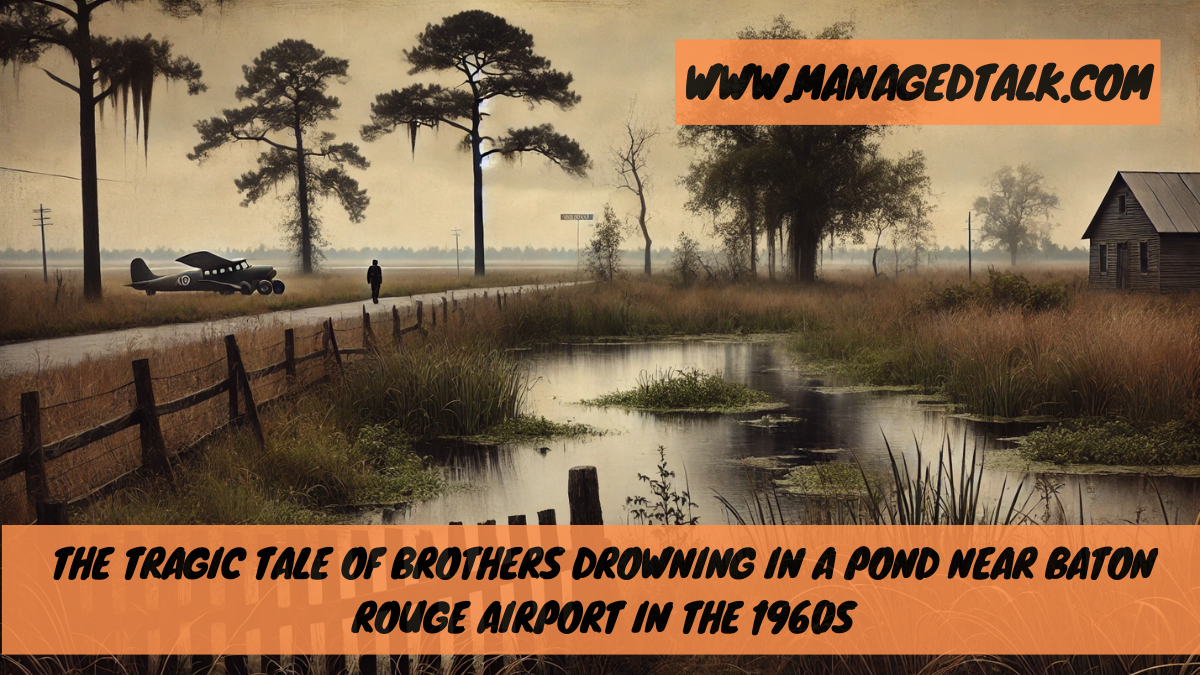The story of the brothefrs drowning in pond near Baton Rouge Airport 1960s is one that resonates with deep sorrow and reflection. This tragic event, involving two young brothers who lost their lives in a rural Louisiana pond, left a profound impact on the local community. It also served as a stark reminder of the importance of water safety and emergency preparedness.
The tragic “brothefrs drowning in pond near Baton Rouge Airport 1960s” highlights a heartbreaking loss of two young brothers, sparking safety reforms and community awareness in the region.
Here, we delve into the details of this heartbreaking incident, its aftermath, and the lessons it left behind.
The Incident: What Happened?
In the 1960s, near Baton Rouge Airport, a serene yet potentially hazardous pond became the site of a devastating tragedy. Two young brothers, whose names have faded from public memory but whose story remains etched in local lore, ventured near the water for an afternoon of exploration and play.
The Unfolding Tragedy
What began as an innocent excursion took a fatal turn. While the exact circumstances remain unclear, reports suggest that one of the brothers slipped into the water. In an attempt to rescue him, the other also ended up in the pond. Despite their desperate struggle, both boys drowned before help could arrive.
The Pond’s Hidden Dangers
The pond, though seemingly benign, was deceptively deep in certain areas, with treacherous undercurrents that even strong swimmers would find difficult to navigate. It was also poorly maintained, with no warning signs or barriers to prevent access, common shortcomings in rural areas of that era.
Community Reaction
The tragic deaths of the two brothers sent shockwaves through the Baton Rouge community. In an era without social media or 24-hour news, word spread through newspapers, local radio, and word of mouth. The tragedy united neighbors in grief and galvanized conversations about safety.
Mourning and Support
The boys’ family received an outpouring of support. Vigils were held, and local churches organized memorial services. This communal mourning highlighted the close-knit nature of mid-20th-century Baton Rouge, where such tragedies deeply touched every resident.
Safety Oversights of the Era
In the 1960s, rural communities often lacked the safety infrastructure needed to prevent such tragedies. This incident underscored several critical gaps:
- Lack of Fencing: The pond was easily accessible, with no barriers to prevent children or unwary passersby from getting too close.
- Absence of Warning Signs: No signs indicated the pond’s depth or its dangers, a common oversight in that period.
- Emergency Response Challenges: With limited communication tools and slower emergency services, the chances of timely rescue were slim.
These factors combined to make the pond a hazard, especially for children.
Lessons Learned
The tragedy of the brothefrs drowning in pond near Baton Rouge Airport 1960s brought much-needed awareness to water safety issues in rural areas. Over time, it led to tangible changes in local policies and attitudes:
Improved Safety Measures
- Fencing and Barriers: Local governments and private landowners began installing fences around potentially dangerous water bodies.
- Warning Signs: The importance of visible warnings near ponds, lakes, and rivers became widely recognized.
- Water Safety Education: Schools and community programs started teaching children about water safety, emphasizing the risks of unsupervised play near ponds.
Emergency Response Enhancements
The tragedy highlighted the need for faster and better-equipped emergency services. This prompted investments in training and infrastructure, ensuring communities were better prepared for future crises.
Reflecting on the Human Impact
While the safety reforms were necessary and welcomed, they could not erase the grief felt by the family of the two brothers. The loss of young lives serves as a painful reminder of life’s fragility and the unforeseen dangers lurking in everyday environments.
A Community United by Loss
The incident united Baton Rouge in its aftermath. Churches, schools, and local organizations came together to support the grieving family and advocate for changes to prevent similar tragedies.
FAQs About the Incident
1. When did the tragedy occur?
The incident happened during the 1960s, near Baton Rouge Airport.
2. Why was the pond dangerous?
The pond had hidden depths and undercurrents, with no warning signs or barriers, making it perilous for children.
3. What changes followed the incident?
The tragedy led to increased water safety awareness, the installation of fences and warning signs, and improvements in emergency response services.
Why the Story Still Matters
The story of the brothefrs drowning in pond near Baton Rouge Airport 1960s is more than just a tragic memory—it is a reminder of the importance of safety precautions, especially in rural areas. It emphasizes the need for vigilance, community support, and proactive measures to protect vulnerable populations.
By reflecting on this heartbreaking event, we honor the lives lost and strive to ensure such tragedies are never repeated.
